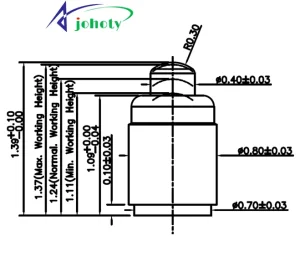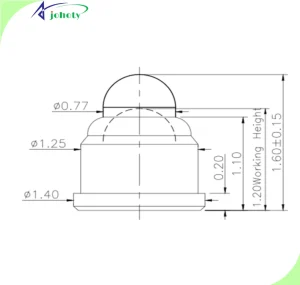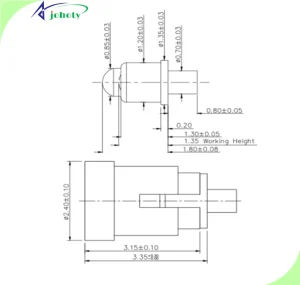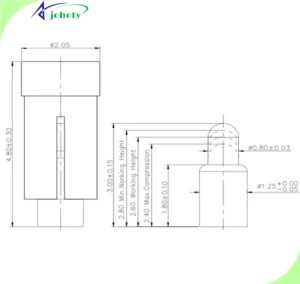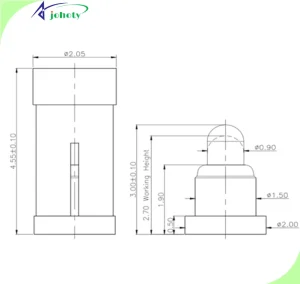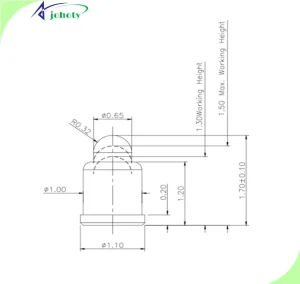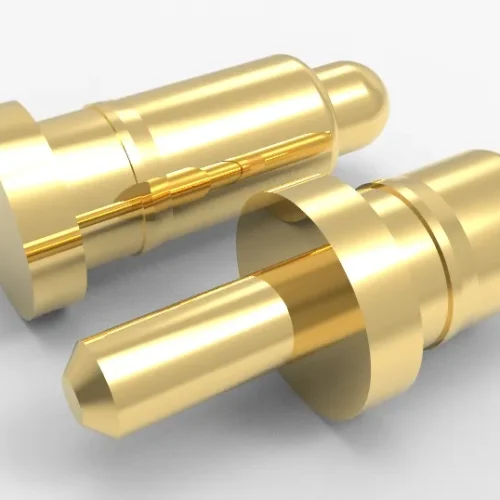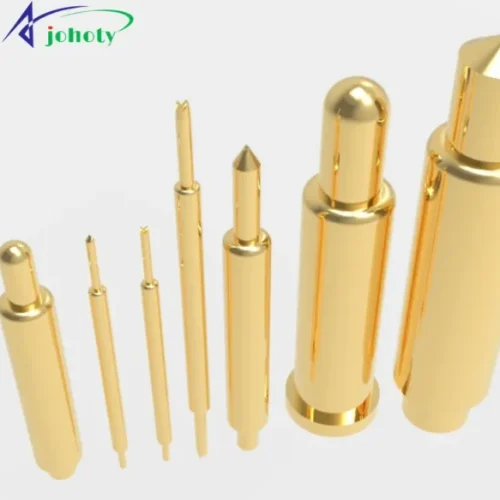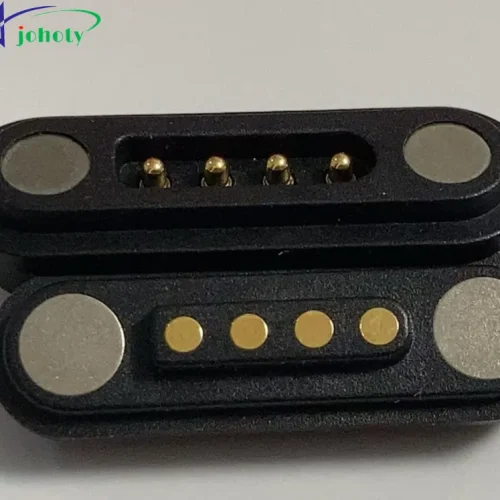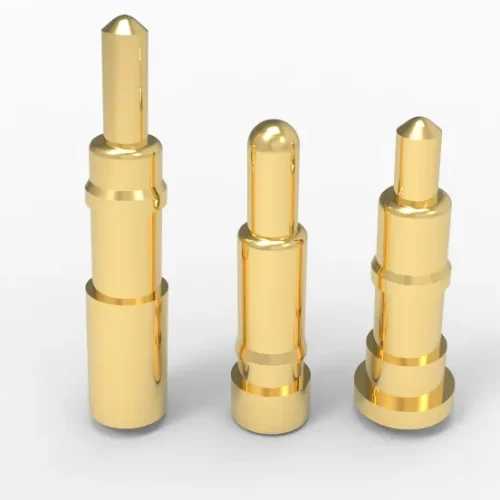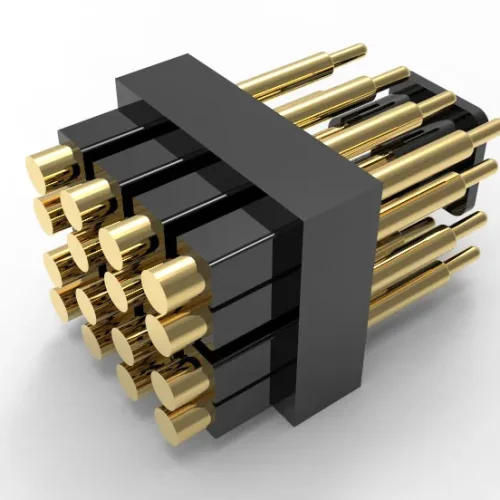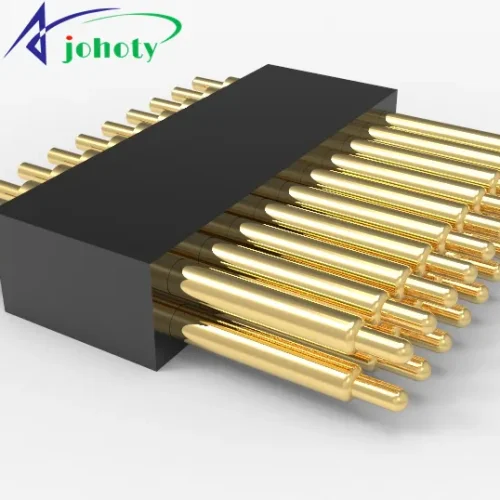Space Saving Design, Reliable 1.39mm Low Profile, Ideal For High-Density UAV Modules. Explore High Performance-Driven Pogo Pin Solutions Now
Introduction: The last 1mm of engineering space saving determines whether the system can operate efficiently
Space saving pogo pins are commonly used in high-density electronic UAVs, industrial robots, medical equipment, satellite communication systems, and other applications. Space is no longer just a unit of size, but has become an extremely scarce resource. System designers are making every effort to compress structural components, optimize circuit board layers, and integrate SOC modules. But it often gets stuck in the connector. Traditional connectors are bulky in size, difficult to stack, and have poor signal integrity. Becoming a bottleneck for high-density design.
At this point, Johoty’s space saving pogo pins serve as a solution for compressing the structure to 1.39mm. It maintains a connection of 1A current and 10mΩ ultra-low contact impedance. Becoming a space saving solution that cannot be ignored by high-end system engineers.
This article is based on engineering, thermal design, reliability, electrical performance, and assembly efficiency. Help you understand why space saving pogo pins are changing the design logic of high-density modules.
Why have we become so demanding about saving space?
In the motherboard of industrial-grade UAV control modules, engineers often need to integrate on a 70mm x 40mm PCB:
- GNSS receiver.
- Three axis gyroscope and accelerometer.
- Main control MCU+AI coprocessor.
- Data Wireless Link Interface (SPI/UART).
- Battery management chip and power supply module.
This type of module is commonly used for aircraft attitude control and trajectory prediction. Therefore, the requirements for stability, insertability, volume, and weight are extremely demanding.
In the past, spring pins with a conventional height of 2.50-3.00mm would occupy an entire layer of packaging height. Designers have to expand PCB area outward or sacrifice stacking space. The pogo pin design with a profile as low as 1.39mm achieves uncompromising release of three-dimensional space:
- Save over 40% of Z-direction height.
- Structural closure design can still be achieved with an edge distance of less than 2.00mm.
- Supports compact distribution of up to 30 interfaces within a 16x16mm matrix.
Typical UAV control modules often use Johoty’s low-profile pogo pins. The overall thickness can be controlled within 4.20mm, which is about 1.60mm thinner than traditional solutions. This has practical improvements in flight time and load weight control.
Stability under Extreme Structures: How does the space saving pogo pin ensure 1A current and 10mΩ impedance?
Does low profile often mean reliability degradation? Not really. The key to the electrical performance after structural compression lies in the following 3 design optimizations:
Multi point contact:
Johoty’s space saving pogo pins feature a three-point contact bowl shaped head design. Combined with the preset pre pressure spring, a stable multi-point closed path is formed with each contact. Greatly reduce the fluctuation range of contact resistance.
During the temperature cycle from -40°C to 85°C, the contact resistance remains between 8~12mΩ. The contact impedance of pogo pins is generally at the level of 50-100mΩ.
Plunger coating optimization:
Adopting hard gold electroplating with a thickness of ≥0.5μm, combined with a base nickel barrier layer, effectively reduces the interference of oxide film. Under this configuration, the plunger can maintain a 10.00mΩ impedance after >50,000 connections.
Double wall design of current carrying channel:
Through the dual conductive path of cylinder and core shaft, the current density is distributed. Easily achieve 1A current carrying capacity within a total length of 1.39mm, with a temperature rise below 22°C.
This is not a miracle of a single material, but a result of targeted engineering optimization. Ensure that pogo pins can be used in lightweight, high stability UAVs, satellites, and portable medical devices.
Thermal design compatibility: No hotspots generated within millimeter-scale structures
One major challenge of high-density modules is the interference of electric thermal coupling. In a closed structure that works continuously for a long time, slight heat accumulation may lead to local degradation.
Johoty’s pogo pin addresses challenges through the following hot design:
- Internal hollow design + thermal conduction path leading out the central heat source.
- The coating material has high thermal conductivity (>150W/mK).
- Multi-point contact reduces the resistance heat per unit contact area.
Under 1A continuous current testing, the surface temperature rise of the pogo pin is only 21.8°C. This is better than the conventional pin’s 32.5°C and is suitable for long-term high current applications.
The small structure of space saving pogo pins does not mean they can only be used for low-power applications
Some customers may mistakenly believe that the space saving pogo pin is only suitable for low voltage and low current when they first encounter it. The fact is exactly the opposite:
- The rated current supports 1A and the voltage withstand voltage reaches 60V DC.
- Support mixed signal and power pin design, with data line SNR loss < -28dB.
- ESD immunity >4kV (IEC61000-4-2 standard).
These performances mean that it can be applied to the following scenarios:
- Multi rotor UAV power bus interface.
- Serial communication and power supply between medical equipment modules.
- Data collection and transfer for wearable industrial devices.
- Quick plug and unplug connections between intelligent module control boards.
We can see that it is a fully functional connector suitable for high-density applications. Instead of small piece products with compromised structures for lightweight loading.
Customer feedback: How do you go from avoiding pogo pins to needing space saving ones?
French drone client has questioned the 1.39mm profile pogo pin: can it withstand pressure with such a thin profile?
Johoty CFT team cooperates with the client to conduct the following rigorous tests:
- Continuous plugging >10,000 times with no significant fluctuation in contact resistance.
- Damp heat aging at 85°C/85% RH, with stable electrical performance after 120 hours.
- Continuous 1A current on and off 1,000 times, without deformation of the contacts.
Test results far exceed its original connection scheme. After a 3-month pilot, the client fully imported Johoty’s space saving pogo pins. Used for all inter board connections of its flight control subsystem. And tell Johoty: Save about 22% of structural space, and save about 15% of operation and maintenance costs for a single set of products due to fewer failures.
Datasheet and Value of Space Saving Pogo Pins:
You can see it isn’t a smaller version, but a next-generation connector solution with comprehensive performance optimization.
| Indicator | Space Saving Pogo Pins | Ordinary spring loaded pin |
|---|---|---|
| height | Low as 1.39mm | ≥2.00mm |
| Contact resistance | 10mΩ | 20~100m Ω |
| Continuous current | 1~3A | 1~10A |
| Life cycles | ≥ 10,000 times, up to 200,000 times | ≥ 10,000 times |
| Temperature rise | ≤20℃ | ≤30℃ |
| Plug fit tolerance | ± 0.02mm | ± 0.05mm |
Conclusion: The next design turning point comes from whether you dare to start over from space saving pogo pins
Connectors are often the last component to be valued in modern electronic engineering. But it is the first physical interface that can determine system reliability.
If you are facing:
- The PCB space has its top 1 limit.
- Modules require faster assembly and higher reliability.
- Unable to tolerate the size and performance limitations of traditional spring loaded pins anymore.
So now is your right time to rethink the space saving pogo pins plan.
Johoty’s space saving pogo pins solution has been implemented in large-scale production in over 30 projects worldwide. We believe that for those of you who take system design seriously, space saving pogo pins are not just a substitute product. But it is the key to pushing you from structural limitations to layout freedom.

